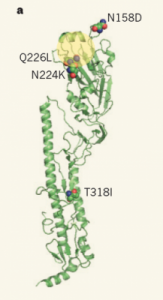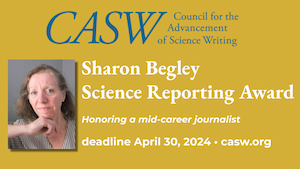MORE ON THOSE CONTESTED STUDIES OF THE H5NI FLU VIRUS. Following up on last week's post on the two much-debated papers investigating whether bird flu viruses can infect mammals and be passed back and forth among mammal species (including, of course, Homo sap): One of the papers has finally been published, the one from researchers based at the University of Wisconsin. which just appeared in Nature. The other, from researchers in the Netherlands, is to be published soon in Science.
This is a big deal, and one way we know this is because two of the universe's top science bloggers have just presented us with more of their H5N1 explainers. Both are splendid examples of the art of science explication, but you should read them both because they overlap hardly at all, although they both take up the history, the science, and the significance of the extended controvery about these papers — and what the future might hold.
Ed Yong's post at Not Exactly Rocket Science delves deep into molecular details of the Nature paper to make four main points: 1. H5N1 can evolve to spread between mammals pretty easily. 2. The evolved virus must be able not only to recognize human receptors but also to remain stable enough to infect them. 3. The specific mutations are less important than what it is that they can accomplish. 4. Perhaps most important: Wild viruses have nearly accomplished these steps on their own.
Yong's conclusion:
They’re the ones to worry about, and they don’t require regulatory approval. The lab experiments could help us to understand how the natural ones are going to play out.
Zimmer's post at The Loom is a comprehensive summary of the history of the H5N1 flu virus going all the way back to its discovery in 1997 as well as forward to the disputed papers and the new publication — not forgetting an explanation of scientific virus-naming conventions and why this particular flu virus is called H5N1.
He also explores the differences between the Wisconsin and Dutch papers, and why some experts found the latter more troubling than the former. And he reports on this week's National Academy of Science workshop on the flu paper controversy.
Zimmer forecasts that the H5N1 episode is only the start of something bigger. NIH, he says, (in the person of Anthony Fauci, director of the National Institute of Allergy and Infectious Diseases) has vowed that vetting of this sort of potentially dangerous experiment will be done in the open. He notes:
Fauci promised that the decision-making about these experiments will be transparent and that we in the press will be able to follow it more closely. That’s the kind of knowledge that we journalists definitely like to have out in the open. You can bet we’ll be holding him to his word.
BONUS! You can download the e-book version of Carl's new book A Planet of Viruses for FREE this month only from the University of Chicago Press.
A SELECTION OF OTHER H5N1 BLOG POSTS. Last week I noted that the Dutch government was demanding that the senior author of the second paper get an export license if he wanted to publish. The license has now been granted, reports Martin Enserink at ScienceInsider. At the Nature News Blog, Brian Owens reports on it too
SciAm reprints a Nature editorial explaining why the journal published the Wisconsin paper. The editorial mulls over the import of these events for decisions about future papers that raise issues like biosafety. The editors reject two proposals made about the H5N1 papers, either publishing redacted versions of potentially dangerous papers or restricting their circulation:
A paper that omits key results or methods disables subsequent research and peer review. Furthermore...we cannot imagine any mechanism or criterion by which to sensibly judge who should or should not be allowed to see the work.
At ScienceInsider, David Malakoff reports on a Senate hearing on dual-use research (the weirdly cold-eyed catchphrase describing research that can be used for both good and evil). It includes details on what influenced the US National Science Advisory Board for Biosecurity (NSABB) to recommend publication.
SHORT SHRIFT. It's easy to spot a young kid who is headed for a violent life, right? Everybody knows that the child who sets fires, tortures animals, and wets the bed is a future criminal and destined for a bad end. This conventional wisdom has even been enshrined in textbooks for decades. Contrarian Karen Franklin analyses a study debunking the shaky evidence for the "homicidal triad" at her forensic psychology blog, and describes how what she calls an urban myth got started.
At Double X Science, Emily Willingham offers instruction on how to read science news. Rule #1: Skip the hed.
Speaking of Double X, at Mims's Bits, Christopher Mims explores the future of robot sex partners and explains why they won't put an end to sex trafficking. One reason is that sex is often not so much about sex as it is about power relationships. Another is that robots will be a lot more expensive than human sex partners.
At the Physics arXiv Blog, KFC presents a paper showing that, contrary to recent claims, Twitter is no good at predictions after all, especially election predictions.
NEW ENGLAND JOURNAL OF MEDICINE BICENTENNIAL. The New England Journal of Medicine would be on any list of the world's best medical journals, and arguably it deserves to be right at the top. That's a position it has occupied for as long as I've been reading it, which is — well, let me be painfully candid here — decades. I don't know whether NEJM has been held in such high esteem for all of its 200 years, but I wouldn't be surprised.
NEJM has established a special site to celebrate its bicentennial, full of this and that, including specially commissioned articles, videos, and a timeline of medical discoveries.
The icing on the birthday cake is Atul Gawande's summation of 200 years of surgery. He is such a fine writer, to wit his opening sentence: "Surgery is a profession defined by its authority to cure by means of bodily invasion." This harrowing topic — almost incomprehensibly horrific in the days before anesthesia — is worthy of his talents. Not to mention the historical astonishments he unearths in the journal's past pages.
For a non-NEJM view of (relatively) recent medical history, at Embargo Watch doc Ivan Oransky describes how NEJM almost singlehandedly invented the weekly cycle of medical and science news that is now tied to publication dates of the top journals. It's not at all clear that was NEJM's intent, but the engraved-in-tablets-of-stone 7-day rhythm of science and medical news dictated by commercial interests is the way it's been for many years. And we in the media dutifully cooperate. Hurray for capitalism.

.png)

